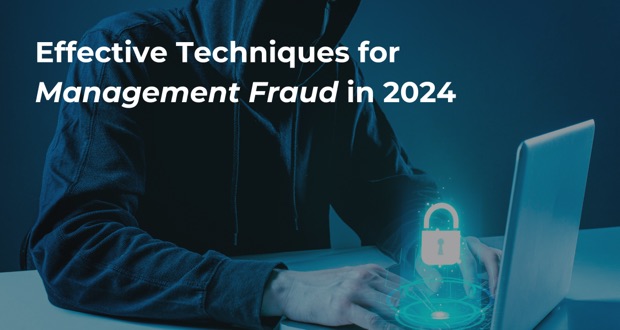Understanding Management Fraud
Management fraud refers to deceptive practices carried out by individuals within an organization who hold positions of authority or influence. Let’s break down the key aspects:
Forms of Management Fraud
- Financial Statement Fraud:
- This involves manipulating financial records to misrepresent the company’s financial health. Examples include inflating revenues, understating expenses, or hiding liabilities.
- The goal is often to create a false perception of financial stability or growth.
- Asset Misappropriation:
- Asset misappropriation occurs when employees or managers steal company assets for personal gain. Common examples include embezzlement, inventory theft, or diverting funds.
- These actions can harm the organization’s liquidity and operational efficiency.
- Corruption:
- Corruption involves unethical practices such as bribery, kickbacks, or favoritism. Managers may abuse their power to gain personal benefits or influence decision-making.
- Corruption damages the organization’s ethical standing and can lead to legal repercussions.
Impact of Management Fraud
These types of fraud can cause severe damage to an organization's financial health, reputation, and stakeholder trust. They can lead to regulatory fines, legal ramifications, loss of customers, and a decrease in market share. Therefore, it is crucial for businesses to invest in types of risk management that include a robust fraud strategy.
As part of broader risk management efforts, businesses may need to employ advanced fraud detection services and solutions. These include predictive analytics and machine learning technologies to identify unusual patterns, flag potential fraudulent transactions, and prevent financial losses. Besides, an anti-fraud management system can provide a comprehensive solution to detect, prevent, and manage fraud-related risks.
Key Risk Management Strategies
1. Enhanced Threat Intelligence
Effective risk management begins with comprehensive threat intelligence. Organizations must adopt a 360-degree approach, understanding not only their own vulnerabilities but also those of their customers and adversaries.
Importance of 360-Degree Intelligence
- Know Your Customer (KYC):some text
- Organizations should gather detailed information about their customers, including their behavior patterns, transaction history, and risk profiles.
- KYC processes help identify potential red flags and prevent fraudulent activities.
- Know Yourself:
- Self-awareness is crucial. Organizations must assess their own vulnerabilities, internal controls, and risk appetite.
- Regular internal audits and risk assessments provide insights into areas that need improvement.
- Know Your Adversary:
- Understand the tactics, techniques, and procedures used by fraudsters. This includes monitoring emerging threats and studying attack patterns.
- Collaborate with industry peers and share threat intelligence to stay ahead of evolving risks.
Using Threat Intelligence for Effective Controls
- Fraud Monitoring Systems:
- Implement real-time monitoring systems that analyze transaction data, user behavior, and anomalies.
- Alerts can trigger immediate action when suspicious activities occur.
- Behavioral Analytics:
- Leverage machine learning algorithms to detect unusual patterns in user behavior.
- For example, sudden changes in spending habits or login locations may indicate fraud.
- Customer Profiling:
- Create detailed profiles of customers based on their interactions with the organization.
- Identify high-risk profiles and tailor controls accordingly.
2. Fast-Cycle Testing
Detecting and Stopping Emerging Threats Promptly
- Agile Testing:
- Traditional testing cycles may miss new fraud techniques. Fast-cycle testing involves rapid iterations to adapt to evolving threats.
- Regularly test fraud prevention measures, update rules, and fine-tune algorithms.
- Threat Simulation:
- Simulate attacks to evaluate the effectiveness of controls.
- Use red team exercises to identify vulnerabilities and improve response times.
3. Advanced Data, Technology, and Analytics
Harnessing the power of data analytics, machine learning, and artificial intelligence can significantly enhance an organization's fraud detection capabilities. Techniques such as anomaly detection and behavioral analysis can provide crucial insights into potential fraudulent activities, enabling swift and decisive action.
4. Integrated Operating Model
Aligning fraud prevention efforts with other business objectives such as client experience enhancement, sales growth, and cost optimization is vital for a balanced and effective risk management strategy. An integrated operating model can harmonize these diverse elements, enabling an organization to strike the right balance between growth and security.
For instance, credit card issuer American Express has adeptly blended its fraud prevention measures with its customer experience strategy. By integrating advanced fraud detection technologies seamlessly into its operations, American Express has managed to maintain excellent customer service levels while combating fraud effectively, thus demonstrating the potential of an integrated operating model.
By implementing these strategies, organizations can proactively combat management fraud while maintaining a healthy business environment. In the upcoming sections, we’ll explore trends and innovations specific to 2024.
Trends and Innovations in 2024
Synthetic Identity Fraud
Synthetic identity fraud continues to be a persistent threat in the digital age. Unlike traditional identity theft, where criminals steal an individual’s complete identity, synthetic identity fraud involves creating entirely new identities by combining real and fake information. Here’s what you need to know:
- Prevalence: Synthetic identity fraud is on the rise due to its complexity and the difficulty in detecting it. Fraudsters use a mix of legitimate and fabricated data to create synthetic personas that can bypass traditional identity verification processes.
- Weak IT Protocols Exploitation:
- Cybercriminals exploit vulnerabilities in IT systems to create synthetic identities. Weaknesses in data storage, authentication mechanisms, and access controls provide fertile ground for fraud.
- Organizations must strengthen their IT protocols, implement robust encryption, and regularly audit their systems to prevent unauthorized access.
- Fake Investment Websites:
- Fraudsters set up fake investment platforms to lure unsuspecting victims. These websites promise high returns, enticing individuals to provide personal information or invest money.
- Vigilance is crucial. Investors should verify the legitimacy of investment opportunities and avoid sharing sensitive data on suspicious websites.
- Social Engineering Scams:
- Social engineering remains a powerful tool for synthetic identity fraud. Criminals manipulate human psychology to extract information or gain access to systems.
- Organizations should educate employees about common social engineering tactics and encourage skepticism when receiving unsolicited requests.
AI-Based Attack Vectors
Artificial intelligence (AI) is a double-edged sword. While it offers immense benefits, fraudsters also leverage AI for illegal activities. Here are some AI-based attack vectors:
- Data Poisoning:
- Fraudsters inject malicious data into training datasets used by machine learning models. This subtly alters the model’s behavior, leading to incorrect predictions.
- Organizations must regularly validate and sanitize their training data to prevent poisoning attacks.
- Snake Oil Algorithms:
- Some fraudsters peddle AI solutions that promise miraculous results but lack scientific validity. These “snake oil” algorithms often exploit the hype around AI.
- Businesses should critically evaluate AI vendors and demand transparency regarding their algorithms’ effectiveness.
- Market Bombing:
- AI-powered bots flood online marketplaces with fake reviews, ratings, or product recommendations. This distorts consumer perceptions and harms legitimate businesses.
- E-commerce platforms need robust AI-driven algorithms to detect and mitigate market bombing.
Fraud-as-a-Service (FaaS)
In 2024, we also see the rise of Fraud-as-a-Service (FaaS) models. Here, cybercriminals offer fraud-related tools, services, or even complete fraud campaigns to non-technical individuals. This democratisation of fraud has seen a shift from dark web marketplaces, traditionally the epicenter for such activities, to more mainstream platforms like deep web messaging apps, further compounding the challenge for authorities and organizations.
In 2021, a global telecom services provider fell prey to a FaaS attack, where cybercriminals offered sim-swapping-as-a-service, leading to substantial financial losses and reputational damage.
In conclusion, staying ahead of management fraud techniques requires vigilance, technological innovation, and collaboration across industries. Business decision makers and executives must adapt to these trends to protect their organizations effectively.
TrustDecision’s AI-Based Fraud Management
Smart Surveillance and Automation
TrustDecision's smart surveillance system collects and integrates data from various sources to perform in-depth analyses and detect unusual patterns. Even with a large transaction volume and rapid transaction velocity, the system runs real-time surveillance and provides results in less than 400 milliseconds, ensuring that no fraudulent activity goes unnoticed, and suspicious transactions are promptly blocked.
Its automation capabilities are based on risk scores, allowing businesses to deep dive into insights for manual reviews when needed. This intelligent automation also reduces the rate of false positives, ensuring that legitimate transactions are not incorrectly flagged, thereby improving the customer experience.
Smart Adaptive Machine Learning
Evolving fraud tactics, from social engineering and identity theft to sophisticated cyberattacks, pose a considerable challenge. TrustDecision's adaptive machine learning algorithms rise to the occasion by learning from each fraud incident and refining their predictive capabilities with every new data point.
Compliance Assurance
TrustDecision understands the importance of compliance in maintaining stakeholder trust. The company maintains comprehensive and accessible privacy policies related to data collection, storage, retention, and sharing practices. Regularly staying up-to-date with evolving privacy regulations, including GDPR and CCPA, TrustDecision guarantees data safety and integrity, helping clients like an insurance company pass stringent regulatory audits.
By providing tools to detect and prevent fraudulent activities, TrustDecision helps businesses operate with confidence and integrity, laying the foundation for a secure and prosperous future.
Conclusion
In summary, staying ahead of management fraud techniques is crucial for organizations to safeguard their financial health, reputation, and stakeholder trust. As we’ve explored various strategies and innovations, here’s a recap:
- Risk Management Importance: Organizations must recognize the significance of fraud prevention and risk management in today’s business landscape. Proactive strategies are essential to mitigate the impact of management fraud.
- Key Strategies:
- Enhanced Threat Intelligence: Organizations should adopt a 360-degree approach, understanding customers, themselves, and adversaries. Threat intelligence informs effective controls.
- Fast-Cycle Testing: Agility in detecting and stopping emerging threats is crucial.
- Advanced Data, Technology, and Analytics: Leverage data analytics, machine learning, and AI for robust fraud detection.
- Integrated Operating Model: Balance fraud prevention with other business objectives.
- Trends and Innovations:
- Synthetic Identity Fraud: Be aware of the continued prevalence of synthetic identity fraud, weak IT protocols, and fake investment websites.
- AI-Based Attack Vectors: Understand the risks posed by data poisoning, snake oil algorithms, and market bombing.
- Fraud-as-a-Service (FaaS): Recognize the rise of FaaS models and their impact on cybercrime.
Operating in the complex and high-stakes arena of risk management, TrustDecision's AI-Based Fraud Management effectively addresses key challenges that organizations often face, including large transaction volume, rapid transaction velocity, evolving fraud tactics, a high rate of false positives, and the need to balance security with customer experience.














